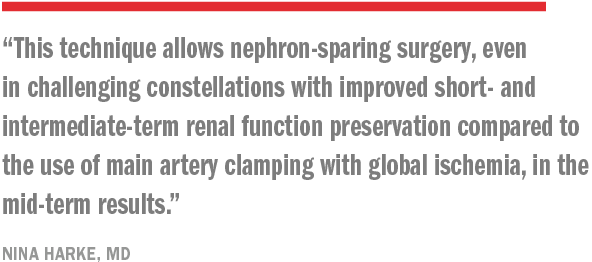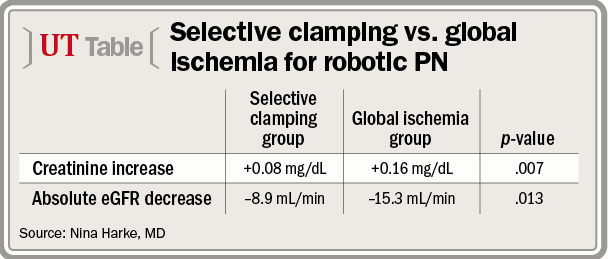Article
Selective clamping promising in robot-assisted PN
Near-infrared fluorescence-guided selective clamping with indocyanine green fluorescent dye in robot-assisted partial nephrectomy appears to be a promising technique to delineate renal tumor anatomy for the bloodless resection of renal masses while minimizing ischemic damage to the kidney.
Madrid, Spain-Near-infrared fluorescence-guided selective clamping with indocyanine green (ICG) fluorescent dye in robot-assisted partial nephrectomy (RPN) appears to be a promising technique to delineate renal tumor anatomy for the bloodless resection of renal masses while minimizing ischemic damage to the kidney.
READ: RT promising in kidney Ca patients with thrombus
In a recent study reported at the European Association of Urology annual congress in Madrid, Spain, patients with renal tumors who underwent RPN combined with selective arterial clamping using ICG showed better postoperative renal functional outcomes than that of a matched pair counterpart that underwent surgery with main artery clamping, according to principal author Nina Harke, MD, assistant medical director and director of scientific research at Prostate Center Northwest, St. Antonius-Hospital, Gronau, Germany.
Applying ICG allows visualization of the disrupted blood flow to the tumor and the renal parenchyma immediately surrounding the tumor, following the selective clamping of the precise tumor-feeding vessels. The technique allows tumor excision in a bloodless field, in an otherwise fully perfused kidney.
Dr. Harke’s investigation studied the data of 50 patients who underwent RPN using selective arterial clamping with the application of ICG, out of a collective of 250 patients who had undergone RPN since 2009. A matched-pair analysis for estimated glomerular filtration rate (eGFR) and retrospective comparison were carried out for 40 matching partners who underwent main artery clamping.

Baseline renal function levels as matching criteria were nearly the same in both groups, with median eGFR of 88.2 mL/min versus 87.7 mL/min (p=.977) and creatinine of 0.88 vs. 0.83 mg/dL (p=.503) for the global ischemia group and the selective clamping group, respectively.
READ: Adjuvant therapy fails in locally advanced kidney Ca
The matched pairs showed no significant differences in mean demographic data for the 40 patients in the global ischemia and selective clamping groups. The median clinical tumor size in global ischemia patients was 30.0 mm versus 33.5 mm in the selective clamping group (p=.170). Accordingly, 74 % of the global ischemia group and 88% of the selective clamping group were allocated to intermediate and high RENAL risk groups (p=.309).
NEXT: Lower creatinine increase in selective group
Lower creatinine increase in selective group
The short-term results of renal function in the matched-pair analysis revealed a significantly lower creatinine increase in the selective clamping group (0.08 mg/dL) than in the global ischemia group (0.16 mg/dL) (p=.007). It also showed a reduced absolute eGFR decrease in the selective clamping group (8.9 mL/min) versus the global ischemia group (15.3 mL/min) (p=.013). These favorable results for selective clamping RPN could be confirmed after 6 (p=.039) and 12 months (p=.011).

The perioperative data were similar with regard to median estimated blood loss (p=.893) and operating time (p=.240). Dr. Harke noted no significant differences in complication rates (p=.115) or in surgical margins (p=1.00).
“This technique allows nephron-sparing surgery, even in challenging constellations with improved short- and intermediate-term renal function preservation compared to the use of main artery clamping with global ischemia, in the mid-term results. Our results revealed a significantly improved renal function immediately after and 1 year following surgery, based on creatinine measurements and the absolute eGFR decrease in the selective clamping group,” Dr. Harke said.
“Today, partial nephrectomy is the gold standard for localized small renal masses,” she added. “However, ischemia time needs to be kept short, especially in complex tumor constellations, to prevent immoderate ischemic trauma to the remaining parenchyma. Selective clamping of the tumor-feeding arteries with near-infrared fluorescence imaging using ICG in RPN enables resection of the tumor without interruption of global renal perfusion.”
You might also like:
Aspirin raises bleeding risk in partial nephrectomy
Nonthermal technique promising for small renal tumors
Adjuvant therapy fails in locally advanced kidney Ca
Subscribe to Urology Times to get monthly news from the leading news source for urologists.
Newsletter
Stay current with the latest urology news and practice-changing insights — sign up now for the essential updates every urologist needs.

















